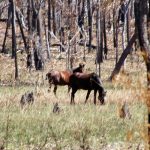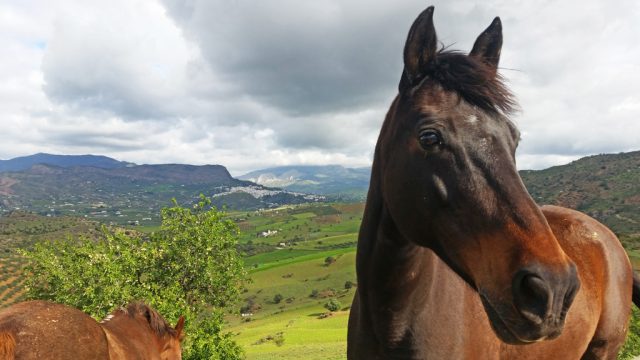 There is a tendency amongst some humans to romanticise the wild. Let us resist the temptation, for the wild can be a hard, uncompromising place. We may also want to bear in mind that the truly wild horse is extinct. All the horses that currently live in the wild are actually feral. This is to say that they or their ancestors used to live in captivity, if only briefly, as in the case of the Przewalski horses. This may appear to be a shortcoming, a detraction from what might otherwise have been a living historical record of horses that are truly wild. And perhaps it is.
There is a tendency amongst some humans to romanticise the wild. Let us resist the temptation, for the wild can be a hard, uncompromising place. We may also want to bear in mind that the truly wild horse is extinct. All the horses that currently live in the wild are actually feral. This is to say that they or their ancestors used to live in captivity, if only briefly, as in the case of the Przewalski horses. This may appear to be a shortcoming, a detraction from what might otherwise have been a living historical record of horses that are truly wild. And perhaps it is.
Yet the existence of feral horses is perhaps far more important to those of us who keep and interact with horses in captivity than their original wild counterparts. This is because it allows us to see how our own horses might actually live and organise their communities were they themselves to return to the wild or be given the chance to do so in captivity. In other words, the existence of feral horses in the wild affords us an opportunity to observe and familiarise ourselves with the natural tendencies and characteristics of horses at this point in their evolution, including those who rely on us for their health and well-being in captivity.
The imperative of movement
From the very first moment when we clap eyes on them, it is clear that horses are designed to move and to do so fairly rapidly if necessary over varying terrain. Relative to their body, their legs are long and are driven by powerful combinations of muscles, while their hooves are hard enough to withstand tough, uneven surfaces, simultaneously absorbing shock through the frog and deep digital cushion.
This initial impression is confirmed by the existence of a relatively small stomach, which suggests that, given their bulk, horses are designed to eat small quantities of food frequently rather than a limited number of large meals.
Confirmation is also obtained from an examination of the hoof mechanism, which not only plays a vital role in protecting the horse in the course of frequent movement but also facilitates circulation in the hoof and legs, compensating for the absence of muscles in the lower legs. Although the circulation of blood to remove waste and introduce nutrition is vital to the health of the hooves, and gravity makes it possible for the blood to drain down the legs and enter them, there are no muscles in the lower limbs to pump the blood back out. This is where the hoof mechanism plays a vital role, allowing the hooves to expand and complement gravity by sucking the blood down when they hit the ground and to then contract so as to force the blood out and up the legs, when the hooves leave the ground as they contract to their original shape. The expansion of the hooves occurs mainly in the rear, allowing the horse’s natural shock absorber (the frog with above it the deep digital cushion) to absorb much if not most of the shock of impact with the ground, thereby protecting the joints and other tissue in the legs and elsewhere.
Taken together, all of these factors show unequivocally that, not only is the horse made for movement, they depend on a good deal of it at frequent intervals, if they are to remain healthy. The reality of horses in the wild confirms this. They are known to move anywhere from fifteen to thirty-five kilometres (just over nine to a little under twenty-two miles) a day and to the extent that the conditions of the wild allow, they are generally quite healthy and fit. Reflection on these factors also suggests a pattern of a relatively brief period of foraging, followed by a snooze repeated throughout most of the day and interspersed at various intervals with social interaction, movement to water and better pasture, at least one brief period of REM sleep while lying down and the relatively few times when they need to evade predators. Observations of horses in the wild largely confirm this.
Highly developed senses
Perhaps the sense that is most obvious to us humans in horses is that of sight. With their eyes situated on either side of their head, it is clear at a glance that horses have a huge field of vision compared to us. In addition, although humans can discern colours and still objects more easily than horses, horses can detect movement, even the slightest, far more readily than we do and they can see in conditions which are far too dark for us to see much, if anything. They are also capable of discerning the slightest subtle movement at relatively short range, especially when it is coupled with a change in energy, for instance, where another horse does little more than tighten their mouth and harden their glance.
Perhaps as legendary as the horse’s capacity for sight is their hearing. Not only does their sense of hearing cover the entire range of a human voice better than a dog’s, it also extends well beyond. Who has not been out hacking or walking with their horse and not noticed that the latter can detect a presence well before it is visible?
Not as well-known perhaps is the horse’s sense of smell, which is arguably as well-developed as that of a dog. Smell helps horses find feed but also plays a vital role in their busy social life, helping them to identify friends and family along with the condition in which they find themselves. As in some other species, there is a neurological link between smell and taste, the two frequently reinforcing each other.
Touch is also a sense in the horse which we humans vastly underestimate. Although some of us point out that a horse is so sensitive to tactile stimuli that they can detect a fly alighting on their coat, so too can we feel one come to rest on our skin. Horses though are also capable of sensing a tactile stimulus which is too light for humans to detect.
(Taken from the second draft of the book, Being Humans for Horses. Click here for more information.)
Questions
When I consider the the imperative of movement in the horse, I am left with a number of questions. If extensive movement is so important for a horse’s health, are they getting enough in captivity? And if they are not, what impact is this likely to have on them and their interaction with us? Is there anything we can do to improve the situation for horses in captivity? If so, what? Do we need to reconsider the way we keep horses? Or do we need to consider the alternative of not keeping horses?
And when I consider just how sensitive horses are, I feel that we are too heavy-handed in our dealings with them. What sort of impact does such heavy-handed ‘communication’ have on such a sensitive, sentient being? Does it impede communication between horses and humans? Is there an alternative? If so, what and how?
Above all, I am left with this question: If we seriously wish to address these questions, what is required of us?
Equine Touch
Our Equine Touch business is called Humans for Horses, you can find our website at:
http://www.humansforhorses.com/
and our Facebook page at:
https://www.facebook.com/Humans.for.Horses
Horses and Humans on Facebook
May I remind you that we now have a Horses and Humans group on Facebook. If you would like to leave a comment, you can do so on this blog or on the the Horses and Humans Facebook group page. All new posts will feature on that page along with additional content posted by any of our members. Please feel free to join us at:
https://www.facebook.com/groups/horsesandhumans/
There is also a Horses and Humans publications page, which contains information concerning the publications released under the Horses and Humans imprint. Some of those publications will be free of charge. You will find it here:
https://www.facebook.com/horsesandhumans
I also have a Facebook page through which you may contact me. You will find it at:
https://www.facebook.com/andrewglynsmail




Indeed very worthwhile and sensible questions you are asking yourself, Andrew… I am sure that at some point in time you will find your answers within yourself….